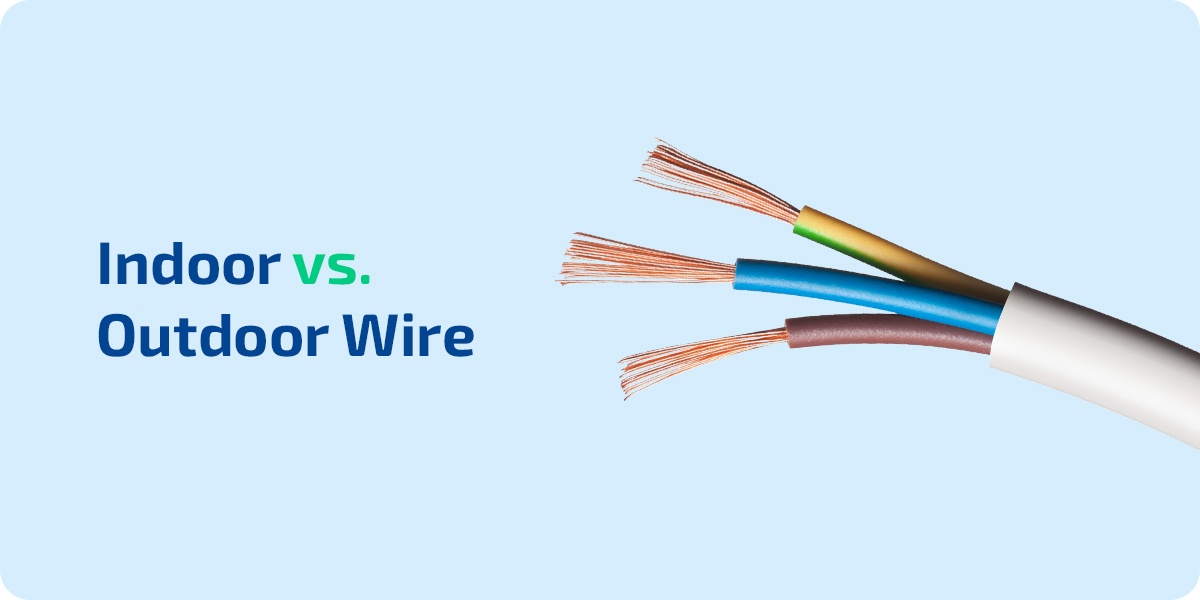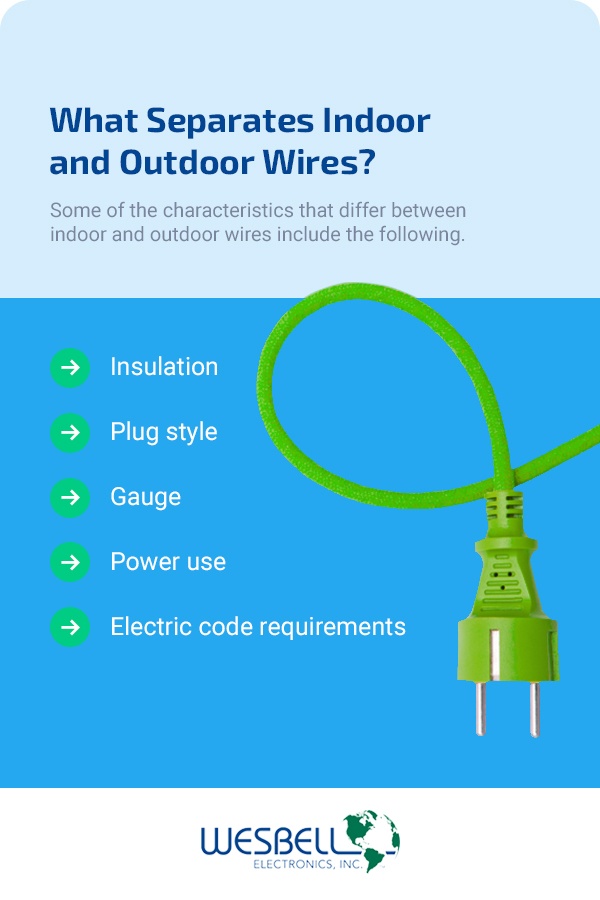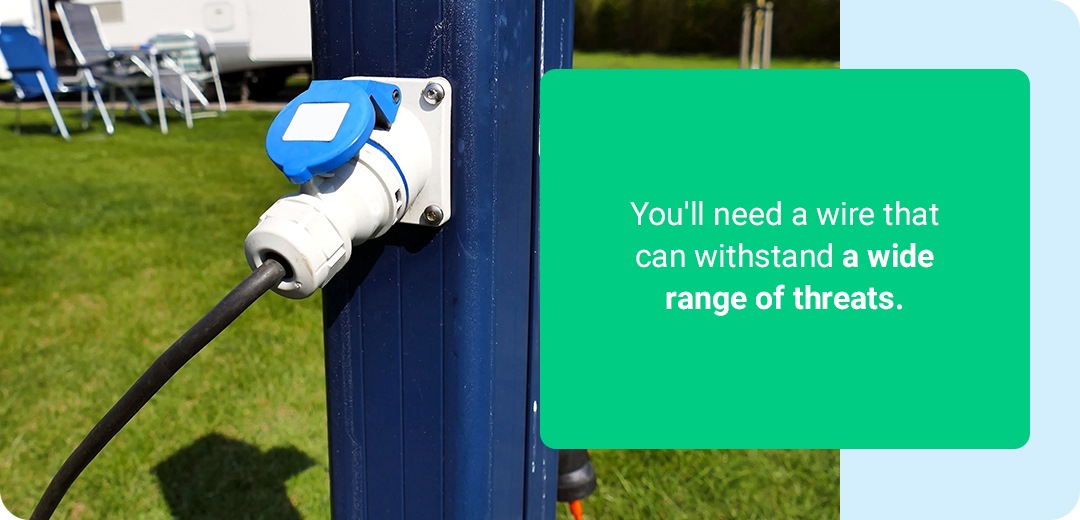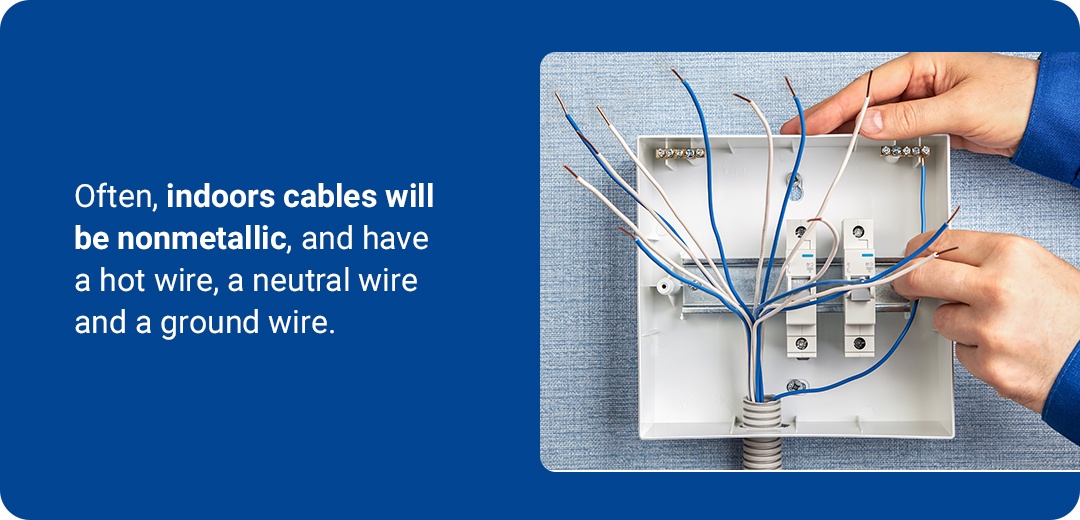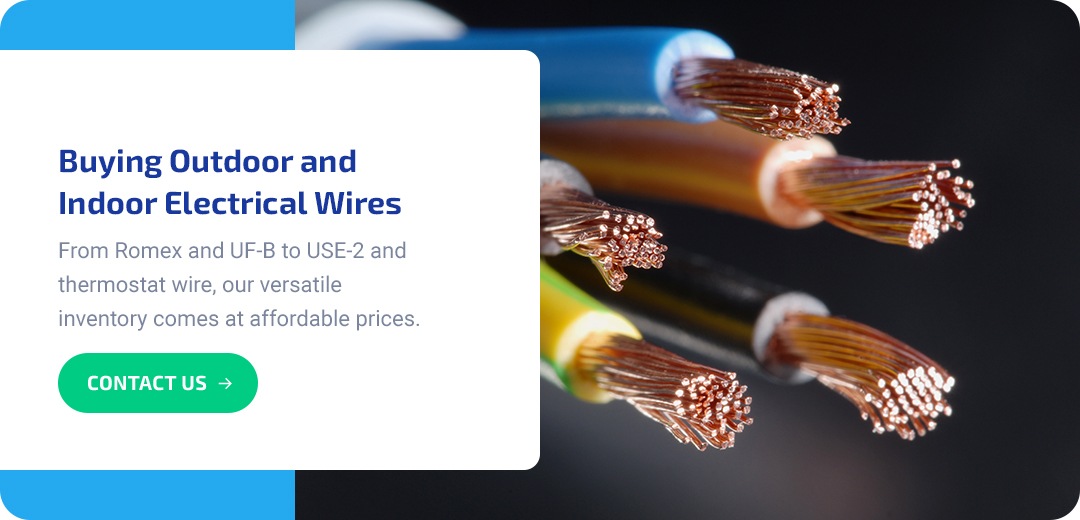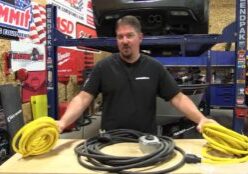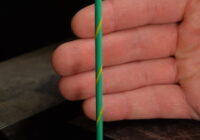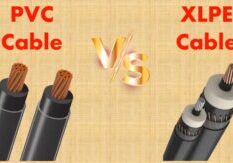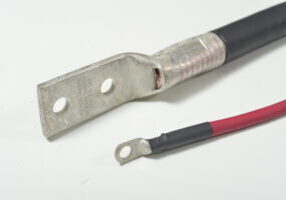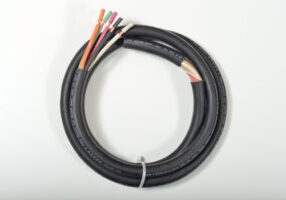
May 20, 2021
Indoor vs. Outdoor Wire
While indoor and outdoor wires may have some similarities, their differences have significant ramifications. Outdoor and indoor wiring fall under different safety codes and use various materials depending on the application. Using a wire in the wrong location can be a critical error, leading to damaged wiring, significant safety risks, and non-functioning electronics.
When it comes to wiring projects, understanding the difference between indoor and outdoor wire is crucial. Whether you’re working on a home improvement project or a commercial installation, knowing which type of wire to use can make all the difference. In this article, we will explore the pros and cons of indoor vs outdoor wire, explore whether you can use indoor wire outside in conduit, and discuss the types of wire suitable for outdoor use.
What is the Difference Between Indoor and Outdoor Wire?
This is a common question among DIY enthusiasts and professionals alike. Indoor wires are typically designed to be used within the controlled environment of a building, where they are protected from the elements. Outdoor wires, on the other hand, are built to withstand harsh weather conditions, UV radiation, and physical wear.
A few factors differentiate indoor and outdoor wires, but the primary goal with outdoor wires is to provide better protection from the elements. Indoor wires don’t get exposed to the same level of risk and require less rugged builds. They’re often more affordable than outdoor wires, but won’t stand up to the same threats that outdoor wires face. That means you can generally use outdoor wires inside, but not vice versa. This rule applies whether you’re using conduit or direct-burial installations.
Some of the characteristics that differ between indoor and outdoor wires include the following.
- Insulation: Outdoor wires must stand up to moisture, humidity and unregulated temperatures. These temperatures can be extreme in many climates, and outdoor cables protect the inner wires with robust insulation. They’re often thicker because of this, but the added protection is essential for keeping the inner wires safe from the elements.
- Plug style: Indoor plugs might be two- or three-pronged, depending on the item. More powerful devices tend to use three-pronged plugs because of the added safety of the ground, but many indoor devices, like lamps and chargers, use two-pronged plugs. They’re a bit easier to work with, but don’t provide a ground check. On the other hand, outdoor cables will almost always have a ground prong.
- Gauge: Indoor wires are often shorter and, since they won’t be pulling as much power, don’t need to be quite as large as outdoor wires. They can have smaller diameters because there’s less current running through them and fewer protective layers are necessary.
- Power use: Devices can vary widely in their power consumption, with indoor wires often accompanying low-amperage devices. For instance, your average household lamp or television might use about 0.5 amps, while a hairdryer or washing machine pulls about 10 amps. Meanwhile, outdoor items like power tools and large lighting fixtures can require a lot more juice. According to WOOD Magazine, power tools like routers and air compressors can use as much as 18 amps, so you’d need an outdoor outlet and wire to handle that current.
- Electric code requirements: The National Electric Code (NEC) specifies various location requirements. The NEC specifies appropriate applications and installation practices, and you must use the right kind of cable according to these requirements to ensure compliance and safety. Indoor and outdoor cables include various ratings for protective characteristics, which must match the application.
Pros and Cons of Indoor vs Outdoor Wire
Indoor wires are generally more flexible and easier to work with but lack the durability required for outdoor conditions. Outdoor wires are robust and weather-resistant but may be more expensive and harder to handle.
Can You Use Indoor Wire Outside in Conduit?
While it is technically possible to protect indoor wire by running it through a conduit, it is not recommended due to potential safety hazards. Outdoor wires are specifically designed to handle external factors that conduits alone cannot mitigate.
Why Is Outdoor Wire Cheaper Than Indoor Wire?
You might wonder, “Why is outdoor wire cheaper than indoor wire?” In some cases, outdoor wires might appear cheaper due to bulk purchasing options or specific material costs. However, it’s essential to compare the specifications and ensure that you are getting a product that meets your needs without compromising safety.
Direct-Burial Wires vs. In-Conduit Installation
Keep in mind that not all outdoor wires are equal—some are rated for direct burial, while others need conduit. Exposed wire also requires care and needs the right rating for its placement.
Outdoor cables rated for direct burial can be placed in an underground trench without any need for conduit. Their durable casing seals out moisture and protects against threats. If needed, you can use these cables with conduit for added protection. You can bury underground feeder cables without conduit with 24 inches of earth cover, while different types of conduit require between six and 18 inches of cover.
Some outdoor wires require conduit, which can consist of different materials and might be more necessary in specific surroundings. For instance, polyvinyl chloride conduit is appropriate for corrosive environments. If you’re laying cable in an industrial setting where corrosive chemicals may be present, this type of conduit may be a good idea. Always carefully consider the application conditions before installing outdoor cable or wire.
You can leave wire exposed in some instances, provided it has the appropriate listing and rating for the application.
What Type of Wire Should You Use Outdoors?
So, you want to run electricity to an outdoor space. What kind of wire do you use? For starters, you’ll need one that can withstand many threats, which may vary depending on the application and the environment. Also, you will likely be looking at a cable, not a wire. Cables feature multiple conductors, and sometimes a ground wire, encased in a protective sheathing.
You’ll need to protect most installations from extreme temperatures. Depending on the climate, this may be more or less of a concern. For instance, if you’re placing a wire in a northern outdoor environment, you could frequently deal with sub-zero temperatures. Alternatively, southern placements can bring toasty temperatures your way, and the Midwest can have both. You must ensure that your outdoor cable fits the climate’s demands.
Other risks that face just about any outdoor cable include condensation, humidity, moisture and ultraviolet rays. Moisture can quickly incapacitate a cable, degrading its performance and ruining the signal. On the other hand, UV light breaks down a cable’s outer layers in the presence of sunlight. When this happens, it significantly diminishes the cable’s lifespan and can lead to cracks in the sheath, exposing the wire to other materials like water.
Note that even UV-protected cables may fade in color, but this is just a cosmetic change. Still, it can make cable identification difficult in the future, so long-lasting color on a wire’s jacket is a definitive plus.
In some locations, such as industrial environments, you’ll also need to consider the presence of substances like chemicals, oil, solvents and fuels. They can eat away at a cable’s sheathing and corrode it to the wire, so appropriate protective layers are necessary.
Some popular outdoor cables include the following.
- Type UF-B: Underground feeder cable, as the name suggests, is often appropriate for direct burial applications without the need for conduit. The “B” in the name refers to its use as a branch circuit cable. It can also be applicable in indoor environments if moisture or corrosion are concerns. This kind of cable has a PVC jacket and color-coded PVC-and-nylon insulation. Conductors can be stranded or annealed soft bare copper wire, with an added bare copper ground. They come in American wire gauge sizes 6 to 14 and support 600 volts and temperatures up to 90 degrees Celsius, dry or wet.
- Type MC: Another indoor or outdoor cable, Type MC cables use THHN — for thermoplastic, high heat and nylon jacket — insulation or the water-resistant version, THWN-2. These insulations are essential for many outdoor applications, including wet and hot environments. The “MC” stands for metal-clad, representing the aluminum interlocked armor surrounding the THHN/THWN-2 wires that helps deliver solid performance in harsh environments. Type MC cables come in solid, stranded and bare copper varieties between AWG 14 and 2. They can be suitable for outdoor use above ground and underground with conduit.
- SE-R: SE-R cables are service entry cables with a rounded shape. They also use THHN insulation but feature a PVC jacket and a ground wire. Typical applications include panel feeder and branch circuits, which benefit from SE-R’s resistance to sunlight, water, and flame retardance. While not appropriate for direct burial, SE-R can be applied in conduit. It operates up to 90 degrees Celsius in wet and dry conditions and comes in AWG 6 to 4/0.
- USE-2: If you’re setting up an outdoor project involving solar power, USE-2 provides the necessary durability. They consist of copper or aluminum wire and flexible rubber insulation, protecting from high heat, wet or damp environments, UV light, abrasion, pressure and chemicals. Temperature ratings can be as high as 90 degrees Celsius and support 600 volts.
What Type of Wire Should You Use Indoors?
If you’re not working in the great outdoors, you can take advantage of less rugged indoor wires or cables that cost less. They typically don’t need the same level of protection as outdoor cables, but they are likely to have flame ratings designated for the application. Often, these cables will be nonmetallic, and have a hot wire, a neutral wire and a ground wire. Another option is to use unsheathed wire, but it will need to be in conduit for protection if it runs in exposed areas.
Some common types of indoor wire include the following.
- Romex® NM-B: Romex wire is popular with branch circuit wiring for residences and smaller businesses and is available in various configurations. It is a Southwire product and even features a special jacket designed for easily pulling it through conduit. Available in AWG 14 to 8, this cable has PVC insulation and a nylon jacket and supports temperatures up to 90 degrees Celsius in dry applications. It’s very similar to UF-B cable but with less protection.
- THHN and THWN: These acronyms might look familiar — that’s because they’re inside the Type MC wires we mentioned earlier. You can use THHN and THWN wires on their own inside conduit. These wires come with different-colored sheathings that indicate their purpose as hot, ground or neutral wires. They often deliver power from an electrical box to the outlets throughout the home. THHN and THWN wires also come in large gauges for more demanding power usage.
- Low-voltage wire: Various low-voltage wires are available for specific indoor applications, like thermostat wire and speaker wire. They are relatively small and usually insulated, but specifications can vary widely depending on the type of wire.
Indoor wire is often more cost-effective because of the reduced need for advanced protective materials. If your project calls for this level of protection, such as damp areas or those with extreme temperatures, remember that outdoor cables can be appropriate for indoor use. You’ll need to check your application carefully and compare it to NEC requirements to ensure it meets the correct standards.
Is There a Difference Between Indoor and Outdoor Electrical Outlets?
The short answer? Absolutely. One significant difference is that outdoor outlets must include ground-fault circuit interrupters.
GFCI outlets are a crucial safety feature significantly reducing the risk of shocks and electrocution. When a ground fault occurs, electricity gets sent into an unintended path outside the wires it was supposed to follow — including through a person, if that’s the fastest path to the ground. A GFCI continuously monitors the electrical current moving through it and cuts off the flow of electricity if it detects a fault. It might still result in a shock, but prevents prolonged electrical contact.
GFCIs are a requirement in specific indoor spaces, such as bathrooms and kitchen countertops, where water is nearby, but they’re always necessary in outdoor outlets of 15 amps, 20 amps or 120 volts. Outdoor outlets also differ in a couple of other ways, including the following.
- Number of holes: The GFCI also means outdoor outlets will have a three-hole design that can accommodate a grounding prong. While most indoor outlets have this, some older ones do not and only accommodate two-pronged plugs.
- Water resistance: Outdoor electrical outlets also have watertight covers to protect the outlet even while the cord is plugged in. That means you can leave your deck lighting plugged in all summer long without worrying about rain or overnight condensation. Of course, indoor outlets have no such protection, but they also don’t typically need it.
Remember that having an outdoor-rated outlet is not enough—you’ll also need to ensure that the plug or extension cord you’re using is safe for outdoor use.
Buying Outdoor and Indoor Electrical Wires
Whether your work calls for outdoor or indoor electrical wires, the experts at Wesbell Electronics can help. We know it’s not always simple to find the most cost-effective wire or cable for the job, especially when weather and application ratings are involved. We aim to make it easy with a massive selection of electrical wires rated for indoor and outdoor use, and a team of experts ready to assist. We’re happy to walk through your project and help you find the best pick for the job.
From Romex and UF-B to USE-2 and thermostat wire, our versatile inventory is affordable, with free shipping when you spend $500 or more. In addition to wire and cable sales, we also offer an array of cable and wire processing services, such as stripping, twisting, and wire harness assembly, so you can spend less time getting cables ready and more time on the job at hand.
Contact one of our skilled representatives today to learn more about indoor and outdoor electrical wires or get help finding the right one for your work.

